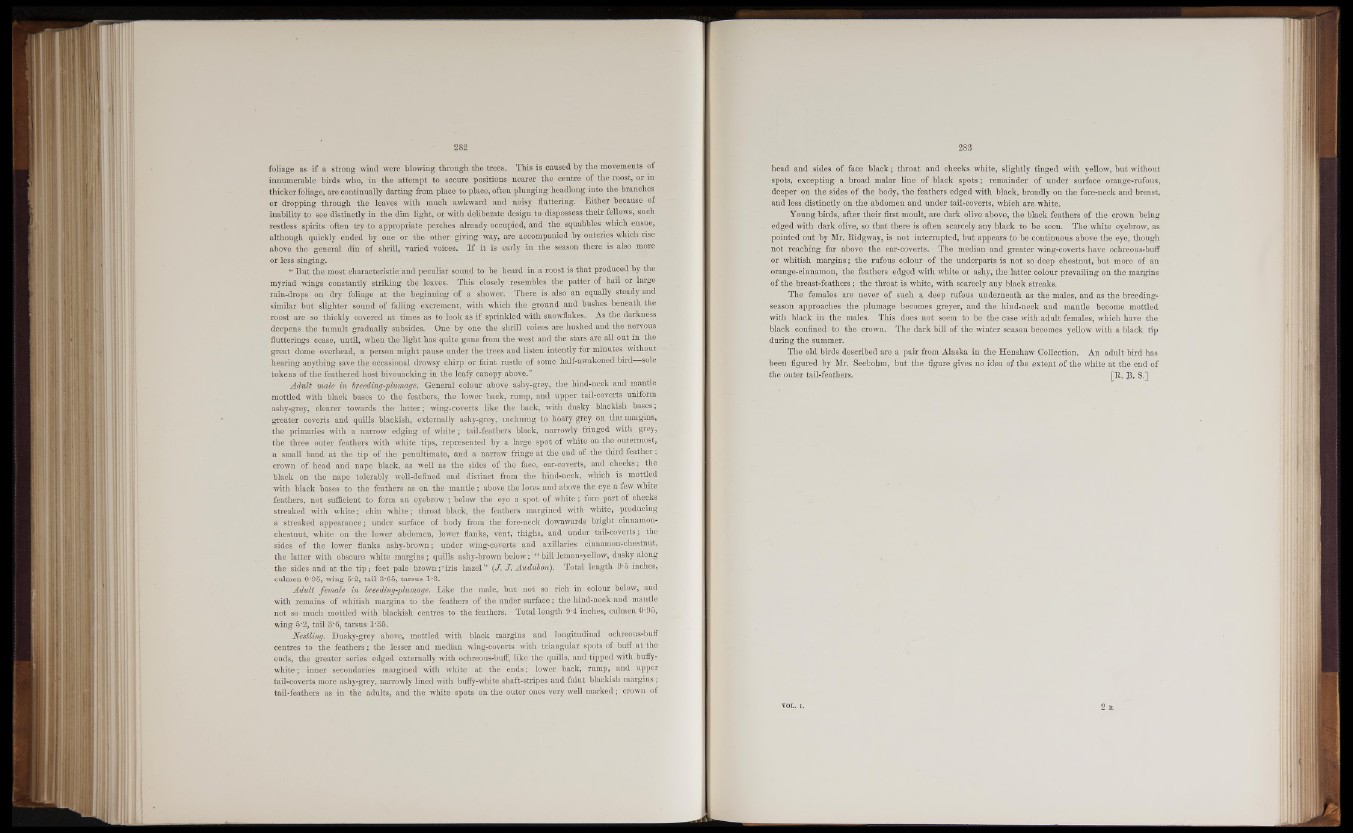
foliage as if a strong wind were blowing through the trees. This is caused by the movements of
innumerable birds who, in the attempt to secure positions nearer the centre of the roost, or in
thicker foliage, are continually darting from place to place, often plunging headlong into the branches
or dropping through the leaves with much awkward and noisy fluttering. Either because of
inability to see distinctly in the dim light, or with deliberate design to dispossess their fellows, such
restless spirits often try to appropriate perches already occupied, and the squabbles which ensue,
although quickly ended by one or the other giving way, are accompanied by outcries which rise
above the general din of shrill, varied voices. I f it is early in the season there is also more
or less singing.
“ But the most characteristic and peculiar sound to be heard in a roost is that produced by the
myriad wings constantly striking the leaves. This closely resembles the patter of hail or large
rain-drops on dry foliage at the beginning of a shower. There is also an equally steady and
similar but slighter sound of falling excrement, with which the ground and bushes beneath the
roost are • so thickly covered at times as to look as if sprinkled with snowflakes. As the darkness
deepens the tumult gradually subsides. One by one the shrill voices are hushed and the nervous
flutterings cease, until, when the light has quite gone from the west and the stars are all out in the
great dome overhead, a person might pause under the. trees and listen intently for minutes without
hearing anything save the occasional drowsy chirp or faint rustle of some half-awakened bird sole
tokens of the feathered host bivouacking in the leafy canopy above,”
Adult male in breeding-plumage. General colour above ashy-grey, the hind-neck and mantle
mottled with black bases to the feathers, the lower back, rump, and upper tail-coverts uniform
ashy-grey, clearer towards the latter; wing-coyerts like the back, with dusky blackish bases;
greater coverts and quills blackish, externally ashy-grey, inclining to hoary grey on the margins,
the primaries with a narrow edging of white; tail-feathers black,_narrowly fringed with grey,
the three outer feathers with white tips, represented by a large spot of white on the outermost,
a small band at the tip of the penultimate, and a narrow fringe at the end of the third feather;
crown of head and nape black, as well as the sides of the face, ear-coverts, and cheeks; the
black on the nape tolerably well-defined and distinct from the hind-neck, which is mottled
with black bases to the feathers as on the mantle; above the lores and above the eye a few white
feathers, not sufficient to form an eyebrow ; below the eye a spot of white; fore part of cheeks
streaked with white; chin white; throat black, the feathers margined with white, producing
a streaked appearance; under surface of body from the fore-neck downwards bright cinnamon-
chestnut, white on the lower abdomen, lower flanks, vent, thighs, and under tail-coverts; the
sides of the lower flanks ashy-brown; under wing-coverts' and axillaries cinnamon-chestnut,
the latter with obscure white margins; quills ashy-brown below: bill lemon-yellow, dusky along
the sides and at the tip; feet pale brown;’iris hazel” {J. J. Audubon). Total length 9*5 inches,
culmen 0*95, wing 5*2, tail 8*65, tarsus 1*3.
Adult female in breeding-flumage. Like the male, but not so rich in colour below, and
with remains of whitish margins to the feathers of the under surface; the hind-neck and mantle
not so much mottled with blackish centres to the feathers. Total length 9*4 inches, culmen 0*95,
wing 5*2, tail 3*6, tarsus 1*35.
Nestling. Dusky-grey above, mottled with black margins and longitudinal ochreous-buff
centres to the feathers; the lesser and median wing-coverts with triangular spots of buff at the
ends, the greater series edged externally with ochreous-buff, like the quills, and tipped with buffy-
white; inner secondaries margined with white at the ends; lower back, rump, and upper
tail-coverts more ashy-grey, narrowly lined with buffy-white shaft-stripes and faint blackish margins;
tail-feathers as in the adults, and the white spots on the outer ones very well marked; crown of
head and sides of face black; throat and cheeks white, slightly tinged with yellow, but without
spots, excepting a broad malar line of black spots; remainder of under surface orange-rufous,
deeper on the sides of the body, the feathers edged with black, broadly on the fore-neck and breast,
and less distinctly on the abdomen and under tail-coverts, which are. white.
Young birds, after their first moult, are dark olive above, the black feathers of the crown being
edged with dark olive, so that there is often scarcely any black to be seen. The white eyebrow, as
pointed out by Mr. Ridgway, is not interrupted, but appears to be continuous above the eye, though
not reaching far above the ear-coverts. The median and greater wing-coverts have ochreous-buff
or whitish margins; the rufous colour of the underparts is not so deep chestnut, but more of an
orange-cinnamon, the feathers edged with white or ashy, the latter colour prevailing on the margins
of the breast-feathers; the throat is white, with scarcely any black streaks.
The females are never of such a deep rufous underneath as the males, and as the breeding-
season approaches the plumage becomes greyer, and the hind-neck and mantle become mottled
with black in the males. This does not seem to be the case with adult females, which have the
black confined to the crown. The dark bill of the winter season becomes yellow with a black tip
during the summer.
The old birds described are a pair from Alaska in the Hen shaw-Collection. An adult bird has
been figured by Mr. Seebohm, but the figure gives no idea of the extent of the white at the end of
the outer tail-feathers. [R. J3. S.]
VOL. i.